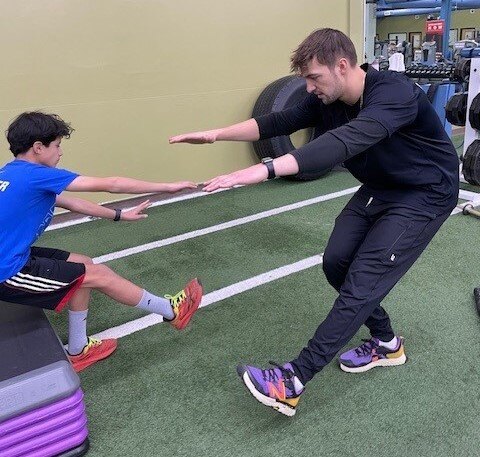When you’re a parent watching your kid play from the sidelines of the field, there’s a sense of pride when you see them kick a goal, hit a homerun, or be the first to cross the finish line. Not only because you’re excited for your child, but also perhaps because you know how hard they worked to be accomplished in their chosen sport. While most young athletes naturally like to move their bodies, it’s important that they do it right. That’s where a personal trainer can change the game.
Brett Messmer recently joined the personal training staff at The Alaska Club West and South. He earned his degree in Exercise Science from North Dakota State University and has also trained in his home state of North Dakota, as well as Idaho, and Jackson Hole, Wyoming. He credits his rural roots for his love of fitness. “I was a farm kid growing up – throwing hay bales, wrangling cows, picking up buckets, carrying heavy loads - it all translates to being a strong athlete.” He says life on the farm prepared him well for high school sports. “I’m a huge advocate of exercise, even at a young age I saw how working out and training for my sport helped me progress.”
Today Brett specializes in training athletes from grade school to college level in various ball sports, hockey, track & field, skiing, snowboarding, and mountain biking. He aims to improve their performance by first teaching them proper form, which is essential for growth. “You don’t have to use super heavy weight to see benefits,” says Brett. In fact, some people confuse weightlifting with strength training. Brett says, there’s a difference. “You can use your own body weight to strength train by doing things like pushups or single leg squats.” There’s also a misconception about strength training stunting growth or injuring growing teens. To avoid injury, he teaches his clients first how to move their body before getting under a barbell. “You have to earn using weights and get the form right first,” He says, “It’s the kids that overdo it who have trouble and can actually hinder their athletic performance.”

When done correctly, strength training can increase muscle strength, protect muscles and joints from injuries, and enhance athletic performance. Perhaps most importantly, Brett says starting a strength training routine when you’re young can last a lifetime and encourage teens to stick with a fitness routine into adulthood. “It’s not just about getting jacked, it’s about being healthy, learning body awareness - how to move it and strengthen it, so as you age, you can still go to the gym as an adult when you’re not playing baseball anymore and use what you learned at a young age.”
Even if your teenager doesn’t play a sport, strength training is important for strengthening bones, promoting healthy blood pressure and cholesterol levels, maintaining a healthy weight, and building confidence. “You can’t burn calories or get stronger playing Fortnite,” Brett says. “Not that I’m against video games, but it’s important to move so you can feel healthy. It doesn’t have to be competitive, just do it!”
If you’re a parent interested in starting a personal training program for your teen, Brett encourages you to reach out to one of the club’s certified trainers, invite your kids to go with you to the gym, build excitement around working out, or even pull up a workout video at home to pique their interest. “Kids like burning energy and feeling strong,” says Brett, “They want to be better, especially if they’re in a sport.” If you’re not ready to commit to hiring a personal trainer, Brett suggests taking advantage of the NextGen Fit classes for tweens or Team Training classes for teens. Both classes are held on the turf areas of the clubs, led by a personal trainer, and focus on functional fitness training. They are free to members and provide a fun, effective workout.

Brett says the key is to be sure you’re moving safely, so you’ll stay healthy for the long run. “Learn the basics on how to stay strong, healthy, and mobile. It’ll not only help you in the short span of youth sports, but also into adulthood.”
Learn more about The Alaska Club’s personal training program at https://www.thealaskaclub.com/personal-training


